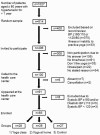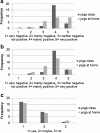Impact of yoga on blood pressure and quality of life in patients with hypertension - a controlled trial in primary care, matched for systolic blood pressure
- PMID: 24314119
- PMCID: PMC4029555
- DOI: 10.1186/1471-2261-13-111
Impact of yoga on blood pressure and quality of life in patients with hypertension - a controlled trial in primary care, matched for systolic blood pressure
Abstract
Background: Medical treatment of hypertension is not always sufficient to achieve blood pressure control. Despite this, previous studies on supplementary therapies, such as yoga, are relatively few. We investigated the effects of two yoga interventions on blood pressure and quality of life in patients in primary health care diagnosed with hypertension.
Methods: Adult patients (age 20-80 years) with diagnosed hypertension were identified by an electronic chart search at a primary health care center in southern Sweden. In total, 83 subjects with blood pressure values of 120-179/≤109 mmHg at baseline were enrolled. At baseline, the patients underwent standardized blood pressure measurement at the health care center and they completed a questionnaire on self-rated quality of life (WHOQOL-BREF). There were three groups: 1) yoga class with yoga instructor (n = 28); 2) yoga at home (n = 28); and 3) a control group (n = 27). The participants were matched at the group level for systolic blood pressure. After 12 weeks of intervention, the assessments were performed again. At baseline a majority of the patients (92%) were on antihypertensive medication, and the patients were requested not to change their medication during the study.
Results: The yoga class group showed no improvement in blood pressure or self-rated quality of life, while in the yoga at home group there was a decline in diastolic blood pressure of 4.4 mmHg (p < 0.05) compared to the control group. Moreover, the yoga at home group showed significant improvement in self-rated quality of life compared to the control group (p < 0.05).
Conclusions: A short yoga program for the patient to practice at home seems to have an antihypertensive effect, as well as a positive effect on self-rated quality of life compared to controls. This implies that simple yoga exercises may be useful as a supplementary blood pressure therapy in addition to medical treatment when prescribed by primary care physicians.
Trial registration: ClinicalTrials.gov NCT01302535.
Figures


References
-
- Kearney PM, Whelton M, Reynolds K, Muntner P, Whelton PK, He J. Global burden of hypertension: analysis of worldwide data. Lancet. 2005;13:217–223. - PubMed
-
- Swedish Council on Technology Assessment in Health Care. Moderately Elevated BloodPressure. 2013. [ http://www.sbu.se/upload/Publikationer/Content0/1/Blodtryck_2004/Hyperto...] (Published October 2004). Accessed October 16.
-
- National Institute for Health and Clinical Excellence. Clinical management of primary hypertension in adults. NICE Clinical Guideline 2011. 2013. [ http://www.nice.org.uk/nicemedia/live/13561/56008/56008.pdf] (Published August 2011). Accessed October 6.
-
- Kjeldsen SE, Naditch-Brule L, Perlini S, Zidek W, Farsang C. Increased prevalence of metabolic syndrome in uncontrolled hypertension across Europe: the Global Cardiometabolic Risk Profile in Patients with hypertension disease survey. J Hypertens. 2008;13:2064–2070. doi: 10.1097/HJH.0b013e32830c45c3. - DOI - PubMed
Publication types
MeSH terms
Associated data
LinkOut - more resources
Full Text Sources
Other Literature Sources
Medical

